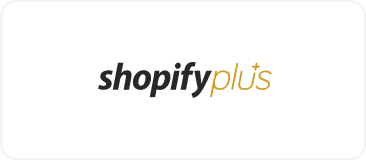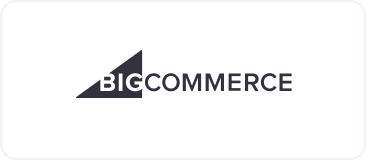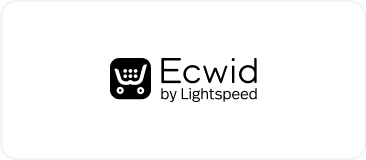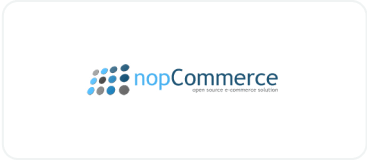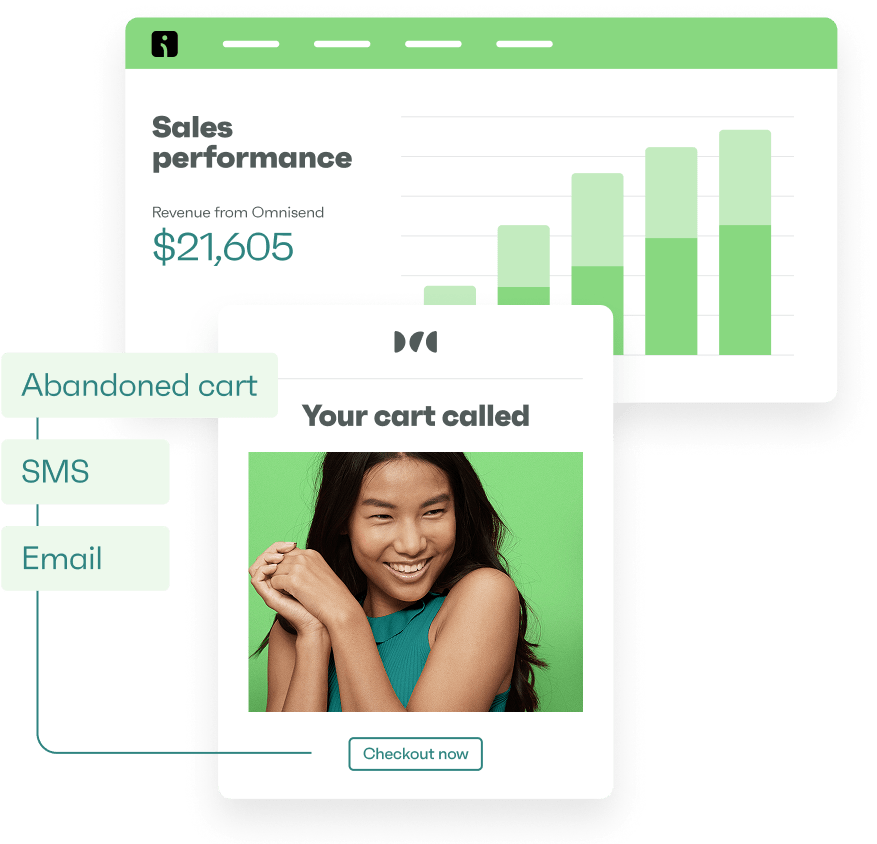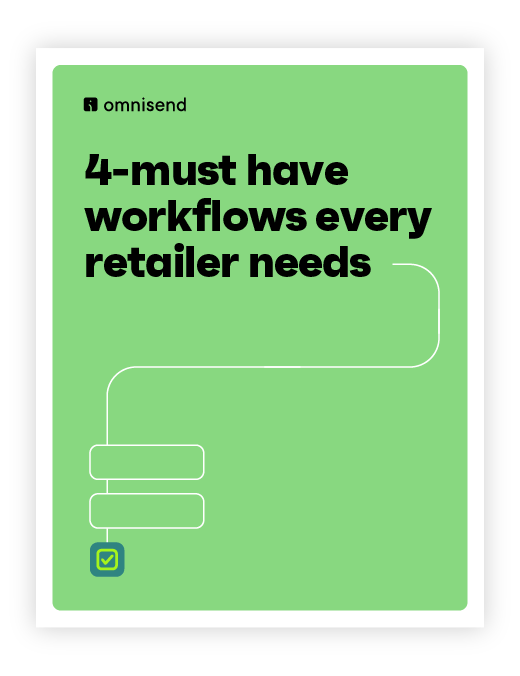
Drive sales on autopilot with ecommerce-focused features
See FeaturesDid you know that ecommerce email marketing can generate a $68 ROI for every $1 spent? Now that’s the kind of number you need to grow in a competitive market.
Email marketing also hands you the reins to every customer interaction. You control the welcome experience, recovery messages, and loyalty rewards, building revenue streams that increase average order value and customer lifetime value.
If you want in, you need an email marketing tool, but it’ll do you no good signing up to any platform and hoping for the best. You need to know what to look for, strategy best practices, and how to measure results. Join us below to learn all you need to know.
Quick sign up | No credit card required
What is ecommerce email marketing?
Ecommerce email marketing tracks shopping behavior to send revenue-generating messages automatically. General email marketing broadcasts brand updates to subscriber lists — ecommerce email reacts to cart abandonment, purchases, and browsing patterns.
Typical ecommerce email automations include:
- Abandoned cart recovery — reminding customers about unpurchased items
- Order confirmations and shipping updates — keeping customers informed
- Product recommendations — suggesting items based on browsing history
- Win-back campaigns — re-engaging inactive customers
- Post-purchase reviews — requesting feedback after delivery
- Inventory alerts — notifying customers when items return to stock
- Welcome series — introducing new subscribers to your brand
- Loyalty rewards — celebrating milestones and repeat purchases
Checkout forms, account creation, and website popups build your email list. Omnisend and similar tools plug into Shopify, Wix, WooCommerce, and BigCommerce to monitor every click, view, and purchase for your ecommerce email marketing automation.
Someone’s browsing winter boots repeatedly? Your system knows and responds with perfectly timed messages that encourage the customer to follow through with a purchase.
Why email marketing works for ecommerce brands
Omnisend merchants generate $68 for every dollar spent on email marketing. Personalized email experiences increased sales for 96% of marketers surveyed — numbers that dwarf returns from paid ads or social campaigns.
Omnisend’s 2025 report also revealed that click-to-conversion rates jumped 27.6% year-over-year, with the UK hitting 14.37% and Lithuania reaching 9.07%. Every third person who clicks an automated email makes a purchase, while scheduled campaigns convert just one in 18.
Your marketing mix likely includes multiple channels, but performance varies dramatically:
- Email leads with 41% of marketers calling it most effective (HubSpot State of Marketing 2025), plus open rates climbed to 26.6% in 2024 (Omnisend 2025 report)
- Social media scores 16% for effectiveness (HubSpot State of Marketing 2025) — algorithms bury your posts unless you pay to play
- Paid search matches social at 16% effectiveness (HubSpot State of Marketing 2025) while costs spike and privacy rules gut targeting
- SMS converts at 2.18% globally (Omnisend 2025 report), despite brands sending 31% more texts than last year
- Push notifications drove 15% of revenue from 3% of sends (Omnisend 2025 report) — decent efficiency but minimal reach
Email lists belong to you forever — Facebook can’t suddenly demand payment to reach people who signed up directly. Marketers using customer data strategically reach audiences 35% more effectively and see 34% ROI improvements (HubSpot State of Marketing 2025).
Salomon Japan reaches 130,000 customers with localized email campaigns, achieving 45% open rates and generating ¥1.9M per campaign. Segmentation by sport category and loyalty tier drives consistent engagement and revenue growth.
Read the case study here.
9 essential email automation flows that drive sales
Consider adding these email automations flows to your ecommerce marketing:
1. The welcome series
First impressions matter, and welcome emails see the highest engagement rates of any automation, making them your best opportunity to convert new subscribers.
Goals
Your welcome series introduces new subscribers to your brand while they’re most engaged. Set expectations about email frequency, showcase bestsellers that hook their interest, and convert browsers into first-time buyers within their initial excitement window.
Study the best welcome email examples for inspiration.
Pro tips
Lead with your strongest offer in email one because new subscribers expect immediate value for sharing their email address. You can also A/B test different welcome incentives, such as percentage discounts, free shipping, or exclusive access to new products.
Include social proof in your emails, like customer reviews, star rating graphics, and Instagram posts, to build trust quickly. Add an expiration date to welcome offers (typically seven to 14 days) to create urgency without being pushy.
Expert insights
“Maximize conversions by focusing 90% of your effort on the first email touchpoint. Our data shows that the majority of conversions happen within the first 30 minutes of signup. Display the incentive immediately on the signup success page, and use that first email or SMS to guide urgency, highlight your bestsellers, and eliminate buying friction. Everything after is just support.”
— Alex Cabrera, We Click Group
“Develop your welcome series in conjunction with the collection of zero-party data on your subscription form to ensure you are talking directly to the prospect regarding the pain point/problem your offer solves.”
— David Bradbury, Founding Partner of May The Growth Be With You
“Make it the Value Bomb. Pack your email with genuinely useful content (internal or external) tailored to your audience to create a “wow, I’ll miss out if I don’t keep opening these” moment. It could include tips, tools, or inspiration that your customers genuinely care about. For example, if you’re a protein brand, it might be a curated gym playlist, calorie calculators, recipe pages, or inspo accounts to follow. This type of email builds trust quickly, drives high click-throughs, and primes strong deliverability signals right from day one.”
— Theo van Wyk, Vanha Digital, Founder
Real-world example
Bodywash and skincare brand Local Revival provides a 15% discount in its welcome series and encourages new customers to shop immediately with a code:
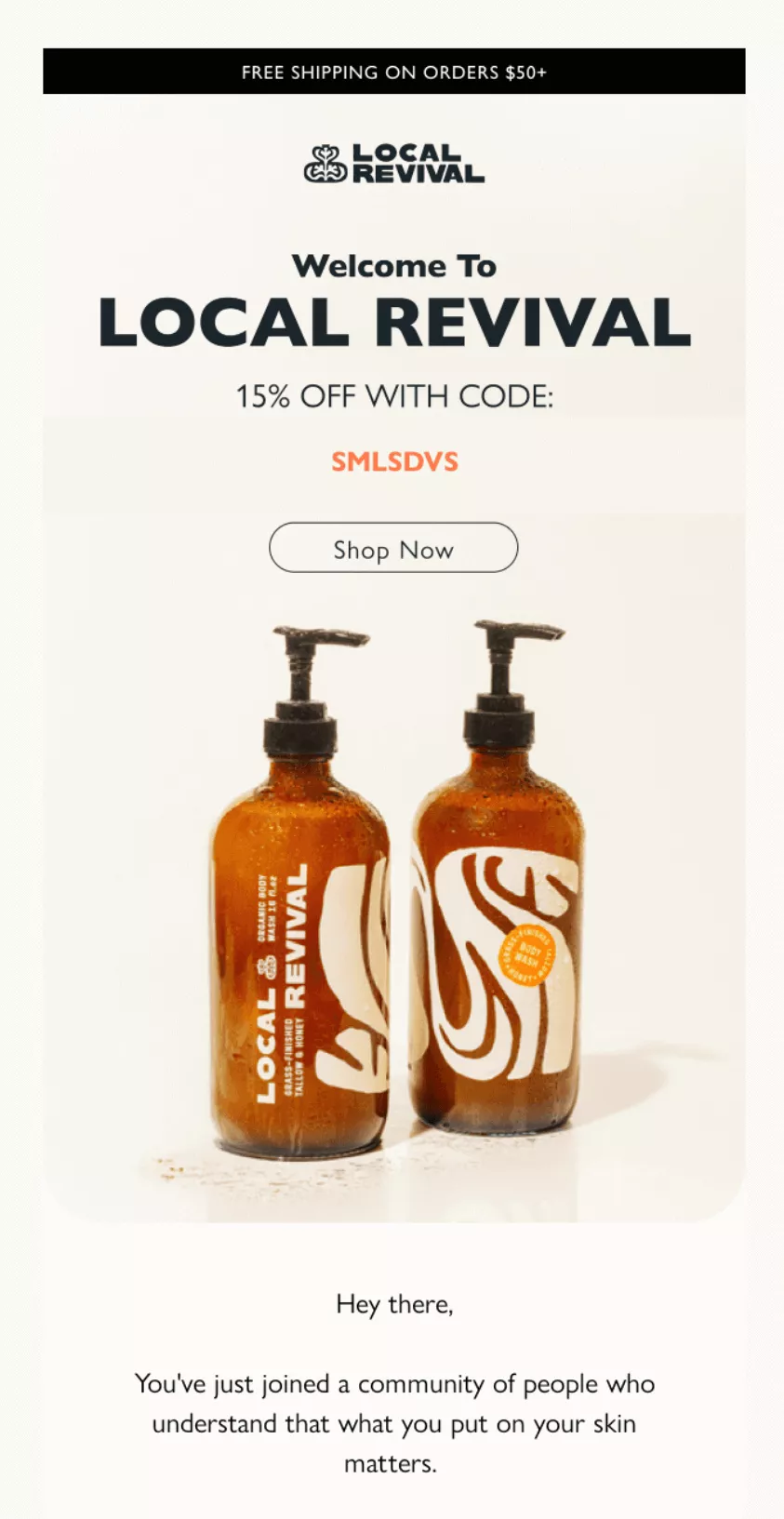
Its subject line, “Welcome to Local Revival,” gets to the point, and further down the email, there’s a list of benefits to the brand, such as no synthetic detergents.
Adding discounts and benefits to your welcome series will increase the chances of customers clicking through to your store and purchasing.
2. The browse or abandoned cart series
Those abandoned carts sitting in your database? They’re filled with customers who got distracted, found unexpected shipping costs, or needed their spouse’s approval.
You can re-target these customers with shopping cart abandonment emails that combine personalized product recommendations with incentives.
Goals
Recovery emails target the massive revenue sitting in abandoned carts across your store. Remove friction points, address common objections like shipping costs, and create urgency without seeming desperate.
Guest shoppers who entered their emails at checkout deserve equal attention as logged-in customers.
Pro tips
Send your first abandoned cart email one to three hours after abandonment while purchase intent remains high. Include product images, prices, and one-click return links to remove any friction from completing the purchase.
Test adding discounts to your second or third email rather than leading with them immediately. Many brands see better results when incentives escalate across the series, training customers to buy at full price first.
Expert insight
“Show the cart contents with big, clear images. Make returning straightforward — one click, no passwords needed.”
— Evaldas Mockus, VP of Growth at Omnisend
Real-world example
Sneaker retailer Kizik sends out a branded abandoned cart email to its customers, leading with a high-quality product image and the conversational heading “You left some shoes behind” to reduce friction surrounding the message:
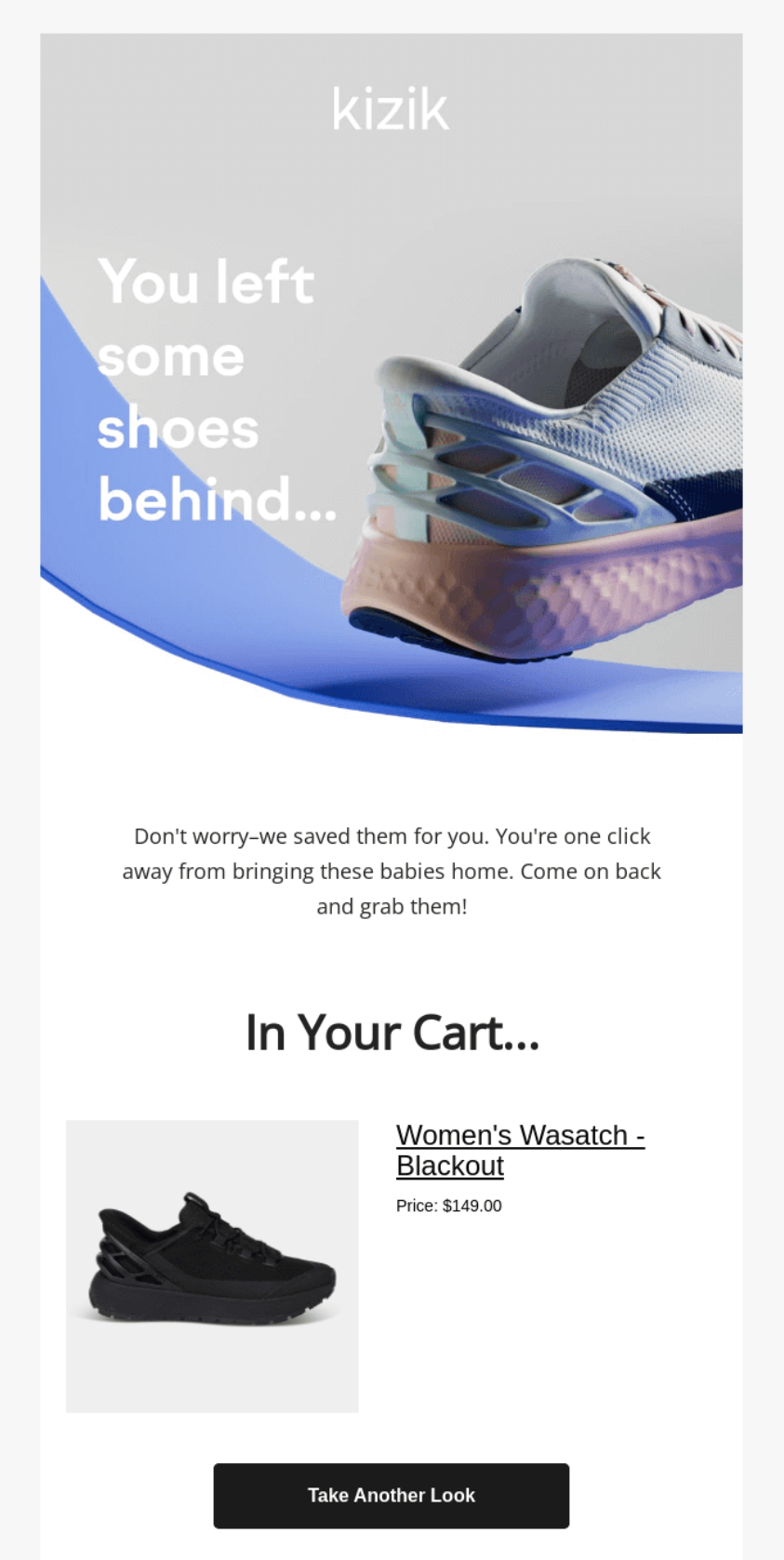
Its branded subject line, “Your Kiziks Are Lonely 😢,” plays on the customer’s emotions rather than being something plain and generic (e.g., You left something in your cart), and reminds the customer about their shopping session and the brand.
3. The promotional series
Sales events need careful timing and segmentation to generate revenue without training customers to always wait for discounts.
Goals
Your biggest challenge during sales? Moving inventory while protecting brand perception. Loyal customers deserve first access to popular items at moderate discounts.
Bargain hunters receive notifications about clearance items last. Each campaign type demands unique approaches — flash sales leverage scarcity, holiday promotions tap into seasonal excitement, and launches focus on innovation stories.
Pro tips
VIP early access creates exclusivity by giving your best customers 24-hour head starts. Countdown timers work, but showing “only 12 left” performs better. Layer your offers — start with free shipping, escalate to percentage discounts only if needed.
Expert insight
“Stack your promotions strategically. Lead with bestsellers that rarely discount, save deepest cuts for slow-moving inventory.”
— Evaldas Mockus, VP of Growth at Omnisend
Real-world example
Probiotic tea retailer Health-Ade sends out promotional emails in the lead up to popular events, with the example below being for its 4th of July sale:
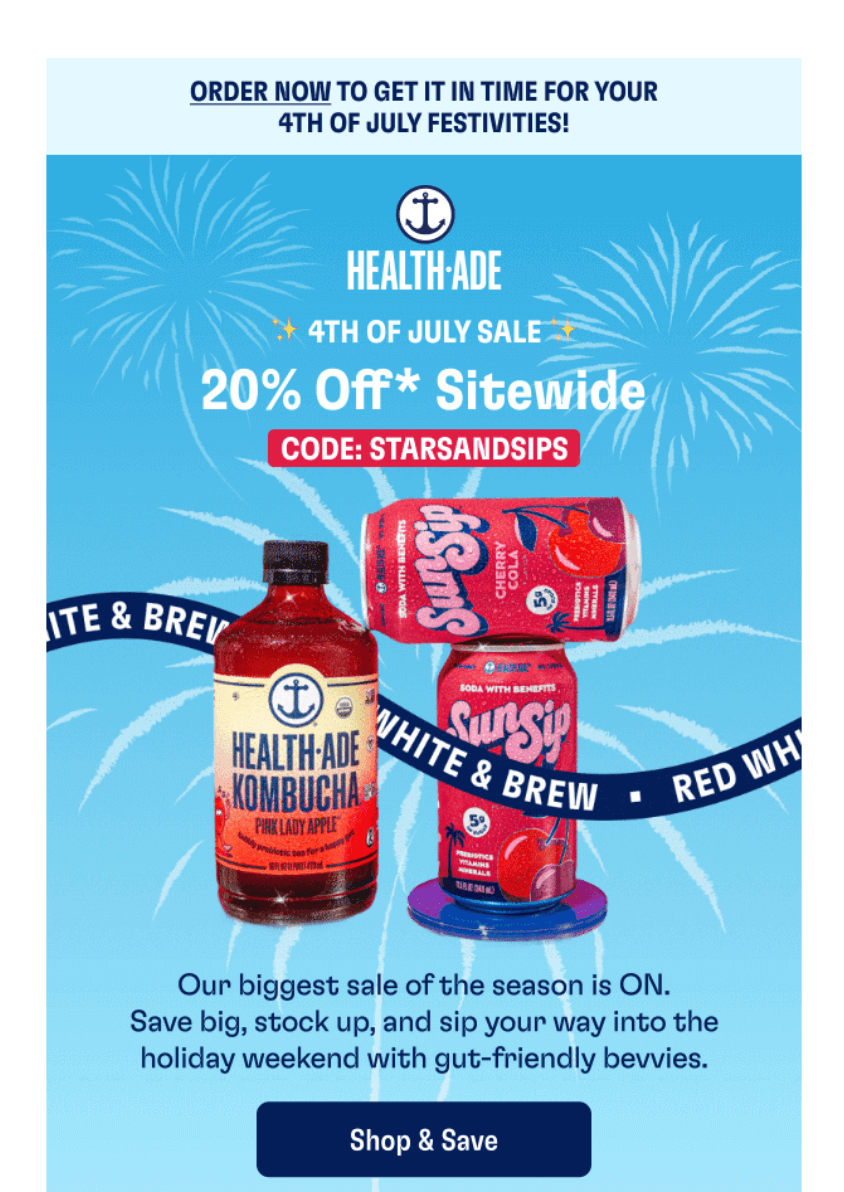
It uses the descriptive subject line “4th of July Sale: 20% Off Sitewide 🔥” to generate excitement and provide upfront value about the email’s contents. The email’s use of high-quality product images and a “Shop & Save” CTA encourages clicks.
4. The new customer “thank you” series
Order confirmations mark the beginning of customer relationships, not the end, creating opportunities for engagement while excitement runs high. Browse thank you email templates to craft memorable messages.
Goals
Thank customers immediately after purchase, deliver clear shipping expectations, and reduce support tickets through proactive communication.
Top brands use these transactional moments to suggest account creation, share brand stories, and subtly introduce complementary products while buyers feel good about their decision.
Pro tips
Send order confirmation within minutes since customers check their email immediately after purchasing. Include care instructions, size guides, or usage tips relevant to purchased items.
Add social proof like “2,847 customers also bought this jacket” to validate their purchase decision. Reference their items in personalized thank you messages — “Hope you love your new running shoes!” beats generic order confirmations every time.
Expert insight
“Turn your transactional emails into marketing opportunities. Add three related products below order details — it’s prime real estate.”
— Evaldas Mockus, VP of Growth at Omnisend
Real-world example
Digital audiobook retailer Libro.fm uses its thank-you series to show appreciation for new memberships and clarify its special offer on audiobook credits:
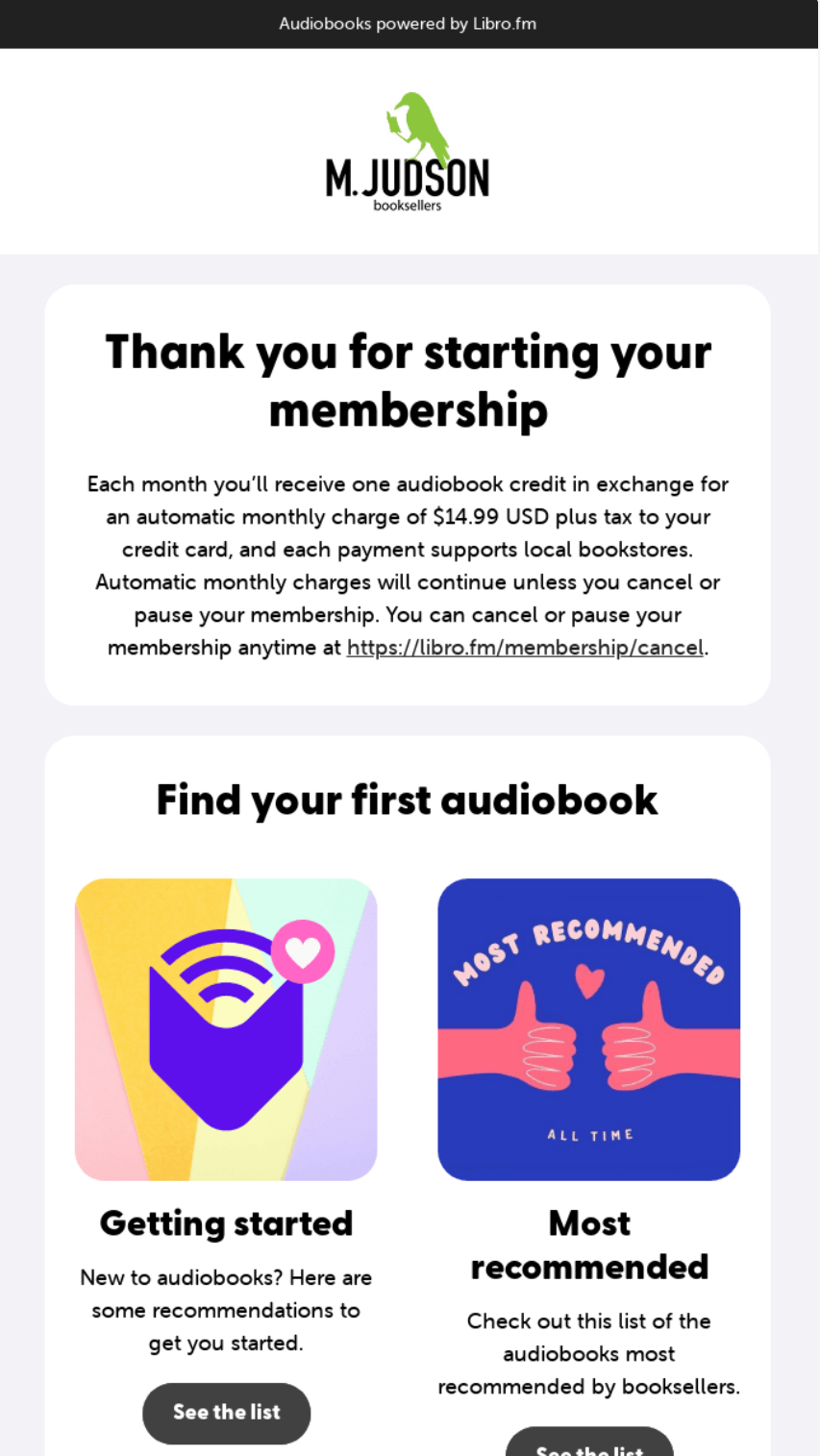
Additionally, its thank-you series includes educational content about getting started, and helps customers find audiobooks with a recommendation list.
5. The post-purchase/cross-sell series
That post-delivery window — when customers unbox their order and love what they bought — creates your best opportunity for suggesting complementary products with post-purchase emails.
Goals
Wait until customers receive and experience their purchase before suggesting additions, typically seven to 14 days after delivery.
Focus on genuinely complementary items that improve their original purchase. Running shoe buyers need socks, coffee machine owners want specialty beans, and skincare purchasers benefit from complete routines.
Pro tips
Match recommendations to purchase history. Bought running shoes? Suggest moisture-wicking socks, not formal wear. Include user-generated content showing real customers using both products together.
Space emails five to seven days apart to avoid overwhelming new customers, and master your post-purchase messaging and offers to maximize lifetime value.
Expert insight
“Use incentives strategically. Some customers will return for a second and third purchase even if you did zero marketing. Your job is to figure out who doesn’t come back and only target them with discounts.”
— Siim Pettai, Founder of Siim Pettai Agency
Real-world example
Fashion brand Boundary Supply sends its cross-sell emails a few days after purchase, recommending bestsellers and related items its customers might like:
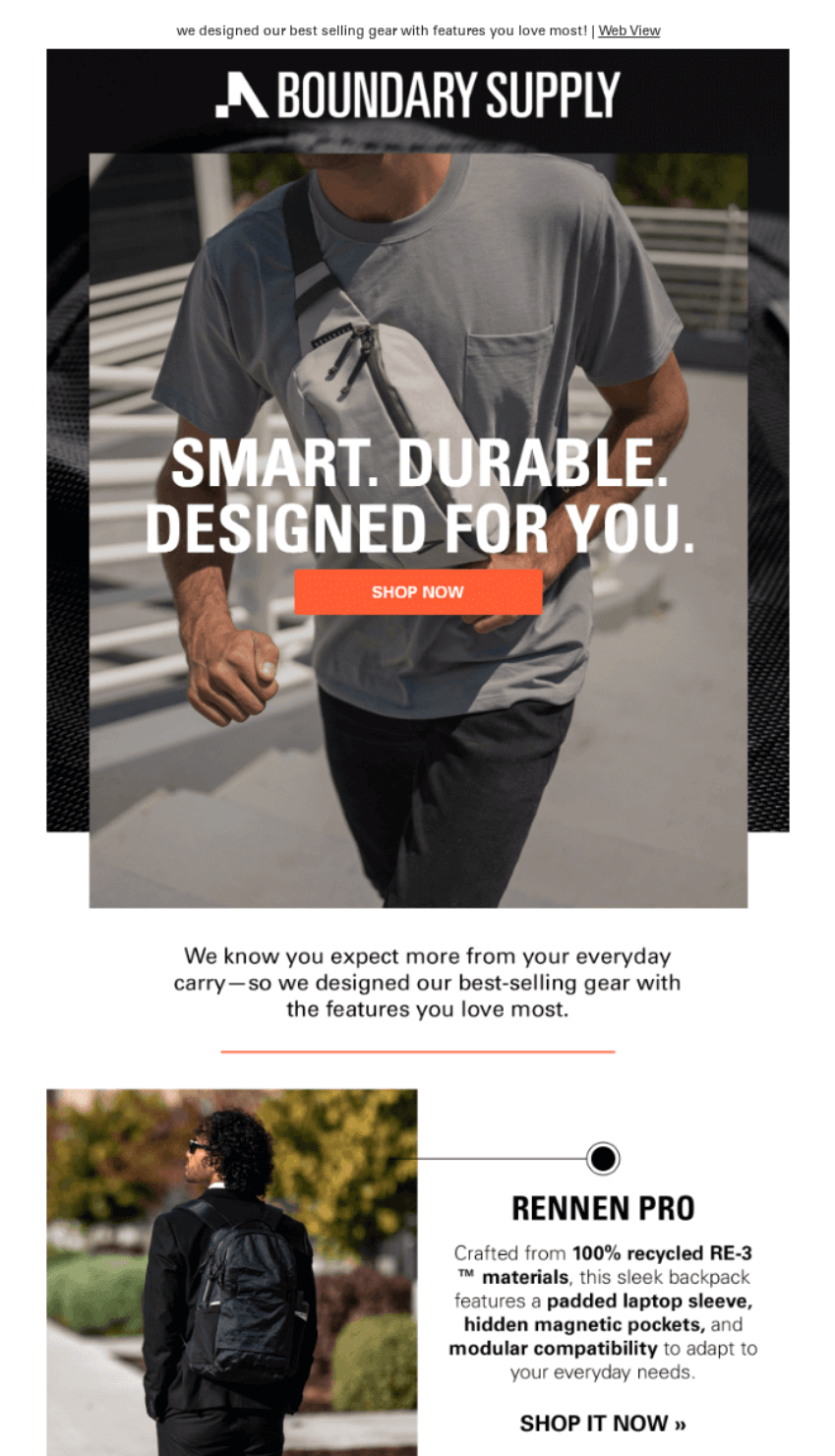
It uses the subject line “🏆 Top Features on Top Sellers” to let recipients know what to expect when they open the email. Being upfront in your emails will help to increase open rates.
6. The product recommendation series
Product suggestions maintain customer relationships between purchases, turning your emails into valuable discovery tools rather than sales pitches. Create effective product recommendation emails that customers want to receive.
Goals
Behavioral data reveals customer interests, so someone browsing camping gear in winter gets tent recommendations come spring.
Monthly touchpoints maintain relationships without pestering, turning your emails into a discovery tool. Unlike one-time cross-sells, these run continuously throughout the customer lifecycle.
Pro tips
Blend trending products with personalized picks based on past behavior. Social proof (“2,847 customers bought this week”) drives action even for unfamiliar items.
Rotate recommendation logic monthly, using purchase history from one month and browsing behavior from the next. Use Omnisend’s product recommender for dynamic personalization.
Expert insight
“Mix bestsellers with personalized recommendations. Customers trust popularity while appreciating personal touches — give them both.”
— Evaldas Mockus, VP of Growth at Omnisend
Real-world example
Meal replacement retailer Huel takes a unique approach to its product recommendation emails, asking its customers to take a quiz to find the perfect product:
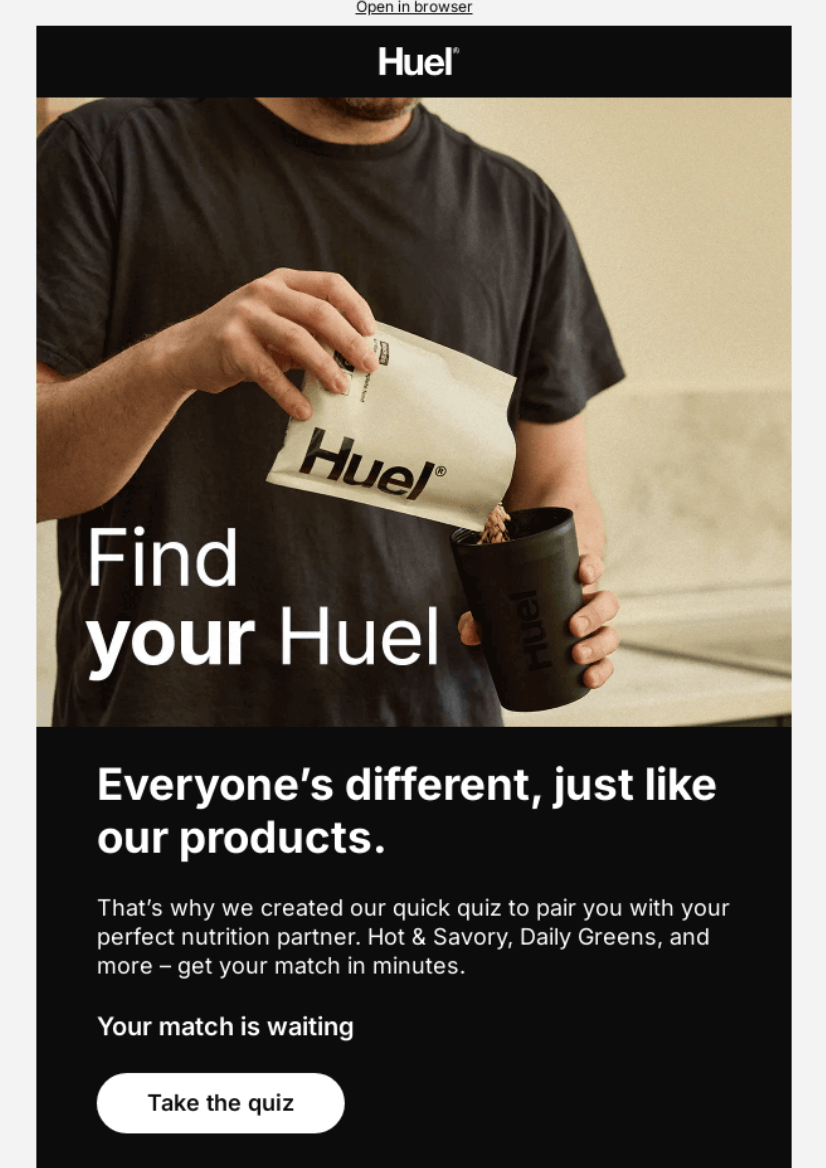
Its subject line, “Hueligan, Your Match Is Waiting 🎯,” also creates a sense of community and triggers brand recognition to increase open rates.
7. The customer win-back series
Past customers represent your lowest-hanging fruit — they’ve already overcome trust barriers, know your quality, and have a buying history you can use for win-back emails.
Goals
Inactivity means different things across industries. Skincare customers typically reorder within 90 days, gadget enthusiasts stretch purchases across six-month windows, and holiday decorators vanish for 11 months straight.
Match your win-back timing to natural buying rhythms. Recently inactive shoppers respond to product updates and “miss you” messaging, while long-gone customers need extra-persuasive incentives to return.
Pro tips
Start gently with “we miss you” messaging before offering discounts. Show what’s new since their last visit.
Create urgency with expiring offers since dormant customers need strong motivation. Consider surveying non-responders to understand why they left.
Expert insight
“Test dramatic subject lines for dormant segments. ‘Breaking up with you’ outperforms polite messages for long-inactive customers.”
— Evaldas Mockus, VP of Growth at Omnisend
Real-world example
Snacks retailer Belgian Boys uses the subject line “We miss you 😭” to encourage opens, and then provides a CTA button that says “Wait, there’s been a mistake” to get its customers to click and start new shopping sessions:
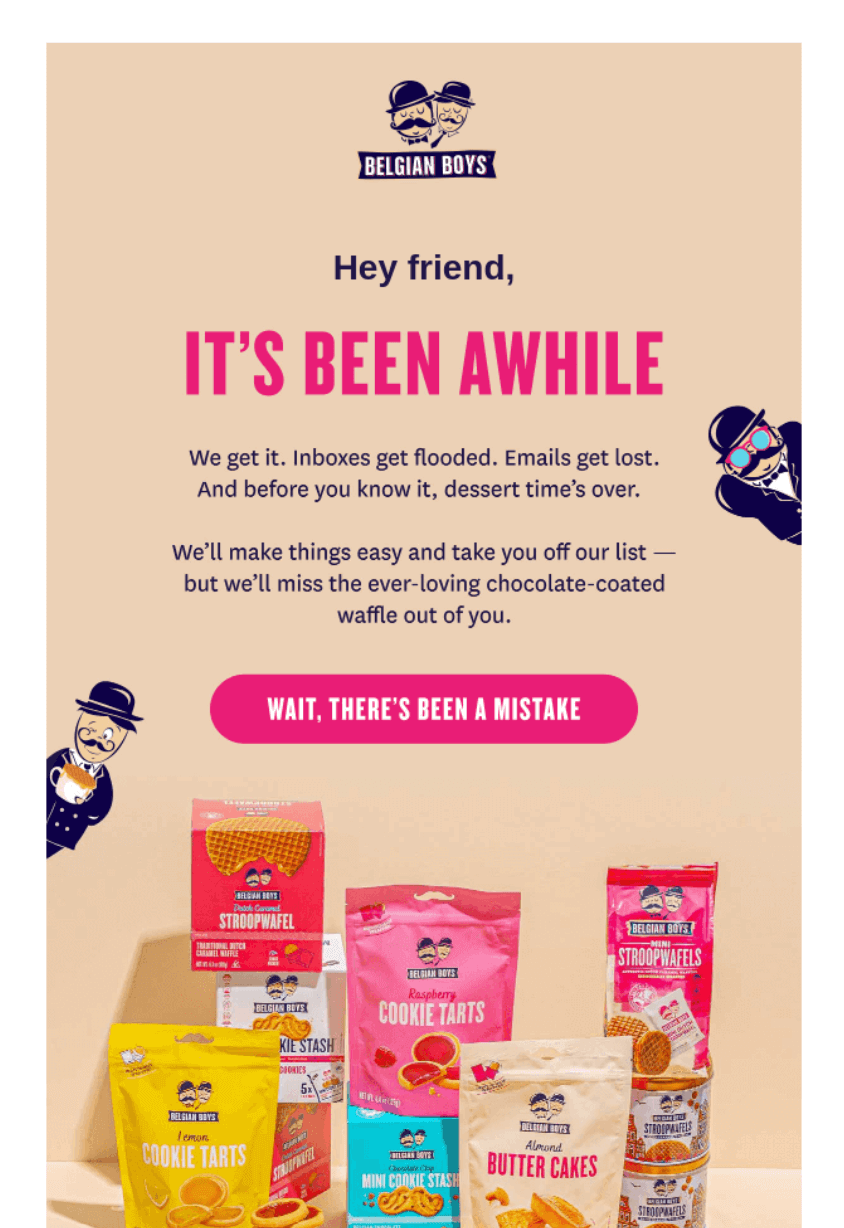
In this case, leading with “We miss you 😭” works as it creates an emotional connection. You can do the same to get eyeballs on your win-back emails.
8. The back-in-stock alert
Stock alerts convert high-intent browsers by notifying customers when their desired items become available again. Perfect your back-in-stock email strategy to capture eager buyers.
Goals
Stock alerts capitalize on proven demand by notifying interested customers when sold-out items return.
These emails see exceptional engagement, with Omnisend data showing 59.19% open rates, because recipients explicitly requested notification. You’re converting high-intent browsers who have already decided to buy.
Pro tips
Add urgency by showing limited quantities available. Include similar alternatives in case the stock sells quickly again.
Enable one-click signup directly from product pages, as popup forms asking for email addresses work better than account requirements.
You can find additional tips by watching this video:
Expert insight
“Trigger alerts the moment inventory updates. Speed matters — popular items sell out again within hours.”
— Evaldas Mockus, VP of Growth at Omnisend
Real-world example
Drinks retailer Better Booch uses the subject line “Back in Stock On All Your Favorites” to immediately capture its customers’ interest:
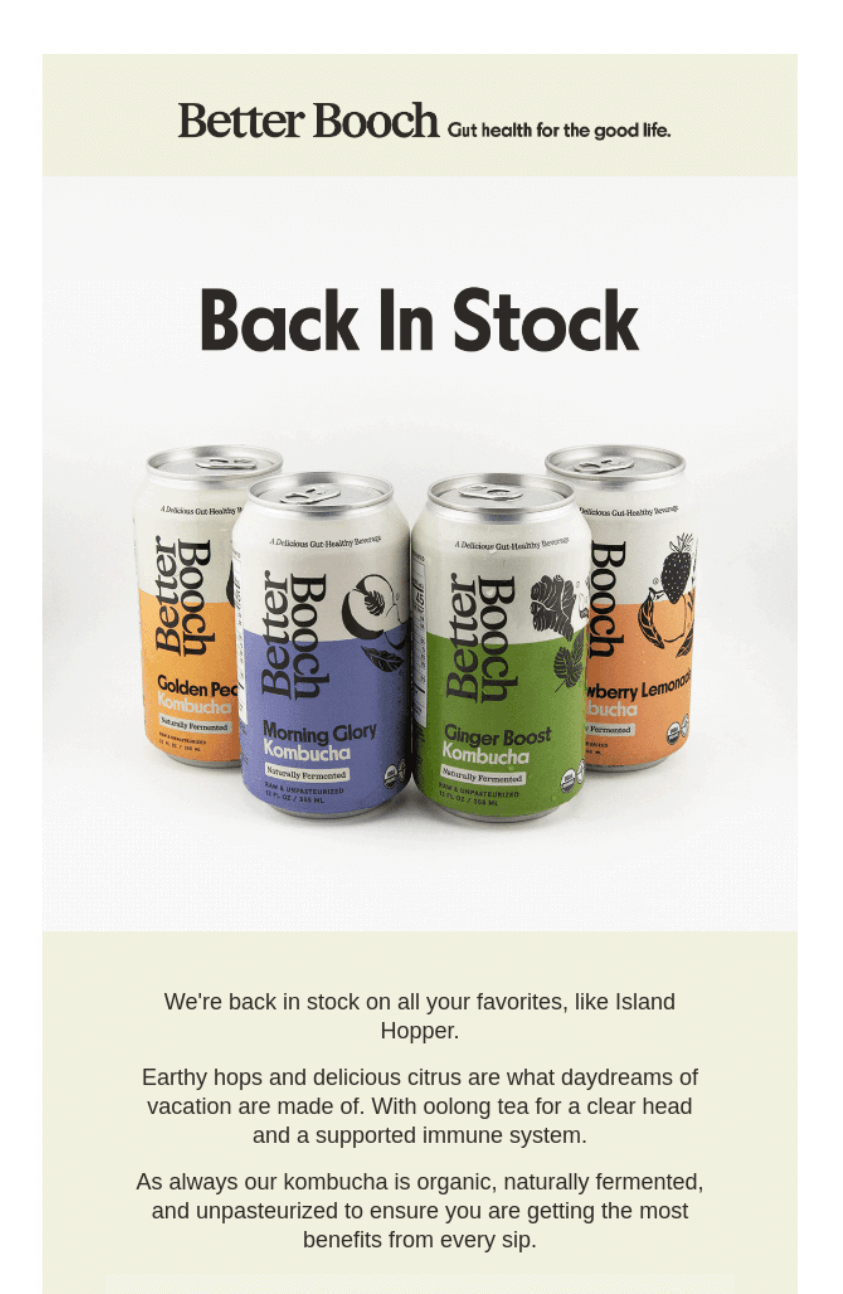
Its email leads with a large Back In Stock heading and then presents an image of popular products to remind customers about its range.
9. The loyalty & VIP reward email
Forget complex point systems — customers stick with brands that make them feel like VIPs, not walking wallets. Build a successful loyalty program that keeps customers coming back.
Goals
Reward everything valuable, not just purchases. Reviews provide social proof worth points. Referrals bring new customers deserving of recognition. Instagram posts spreading brand love earn rewards, too.
Visual progress tracking gamifies the experience — showing “87% to Gold status” motivates that extra purchase. Unexpected birthday discounts and anniversary surprises create memorable moments.
Pro tips
Recognition beats rewards, so celebrate account anniversaries and social shares alongside purchases. Display tier progress prominently. Early sale access costs nothing but makes VIP members feel special. Free shipping thresholds encourage larger orders while rewarding loyalty.
Expert insight
“Make status visible everywhere — emails, accounts, even packaging. Recognition motivates more than points alone.”
— Evaldas Mockus, VP of Growth at Omnisend
Real-world example
Wellness retailer Organics Ocean offers its VIP members 25% off their first four months of subscriptions using the code VIP25:
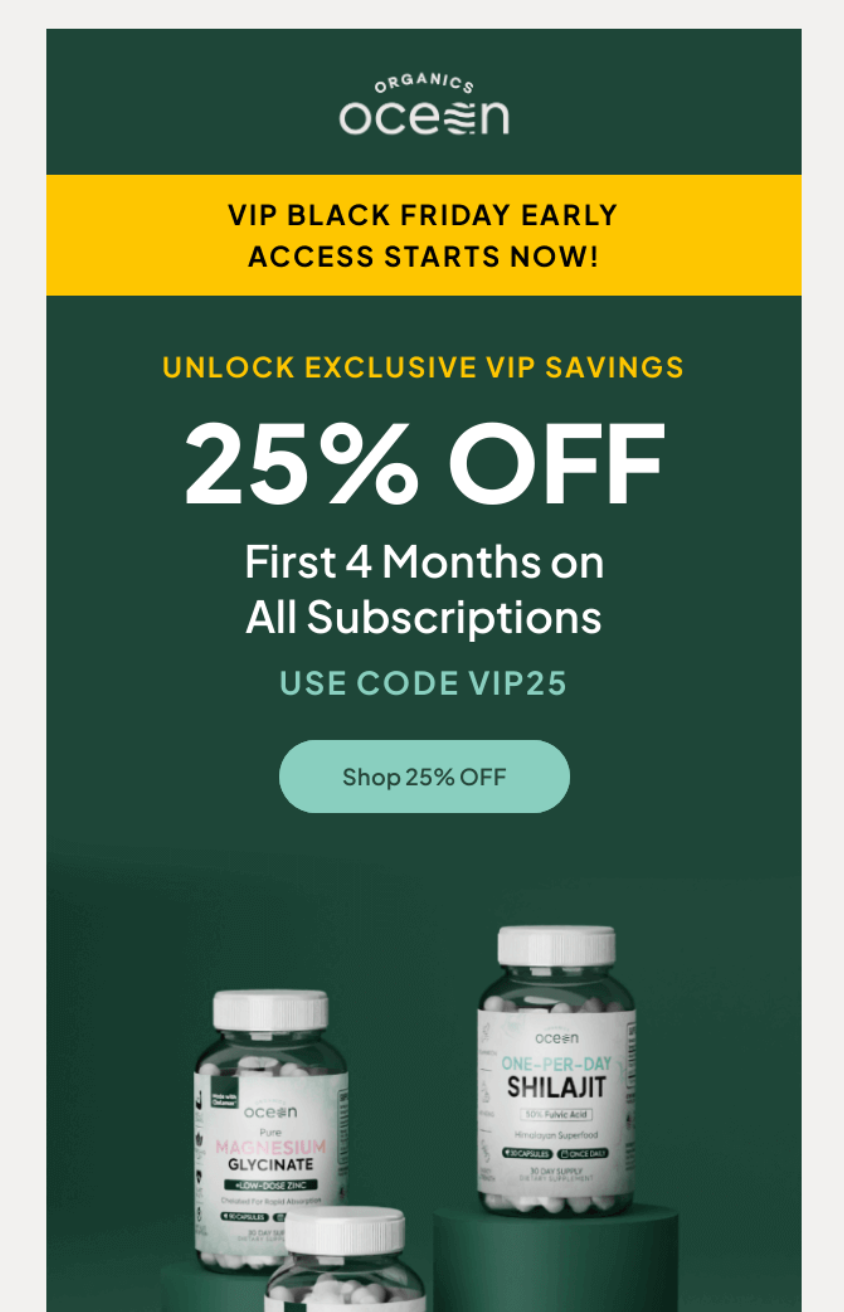
You could offer similarly significant discounts to encourage new VIP signups and increase average order values per customer.
Key metrics and best practices to improve your email marketing in 2025
Forget vanity metrics like opens — revenue drives your business forward. These four measurements reveal whether your email strategy works:
- Click-through rate (CTR) shows who engages beyond reading subject lines. Unique clicks divided by delivered emails gives you the percentage. Ecommerce brands typically see 2–5%, while automated flows often double those numbers.
- Conversion rate tracks buyers, not browsers. Omnisend data reveals that one in three automated email clickers make purchases, versus one in 18 for regular campaigns. Calculate by dividing purchases by total emails delivered.
- Revenue per email (RPE) answers the only question that matters: how much money each send generates. Total revenue divided by emails sent tells you which campaigns and automations deserve more investment versus those eating resources.
- List growth rate predicts future success — new signups minus unsubscribes and bounces, divided by your total list, multiplied by 100. Positive percentages mean you’re expanding reach, and negative means trouble ahead.
A/B testing framework
Random experiments waste time. Follow these four steps for tests that improve performance:
Step 1 — Test one variable
Subject lines, send times, or discount amounts — pick one. Multiple changes muddle results. You want clear proof of what worked or failed.
Step 2 — Write a measurable hypothesis
“Subject lines with emojis will increase open rates by 20%” creates a benchmark. Vague goals like “test different subject lines” provide no direction or measurable outcome.
Step 3 — Wait for statistical significance
Most email platforms calculate this automatically. Aim for 95% confidence before declaring winners. Small lists need longer test periods, sometimes spanning weeks, not days.
Step 4 — Document and implement
Save your best subject lines and other elements for use elsewhere in your automations. Failed tests reveal what your audience rejects — equally valuable information.
Omnisend’s A/B testing lets you compare subject lines, sender names, email addresses, and content simultaneously. Split your audience into test groups, wait one to 24 hours for results, and it automatically sends the winning version to your remaining contacts.
2025 best practices
Email marketing tips evolve as technology and regulations shift. Here’s what matters now:
- Cut inactive subscribers — Anyone silent for six months drags down deliverability and inflates costs
- Collect zero-party data — Preference centers and post-purchase surveys replace dying third-party cookies
- Design for dark mode — Test emails in both light and dark settings, as more users enable this feature
- Navigate Apple MPP — Focus on clicks and conversions over opens, since Mail Privacy Protection (MPP) affects open rate accuracy
- Add user-generated content — Customer photos and reviews in emails provide authentic social proof
- Design mobile-first — Single columns, 14px+ fonts, and tappable buttons accommodate how most people read email
- Build in accessibility — Screen readers need alt text and logical heading structures, as this often leads to better deliverability
- Segment beyond demographics — Group your customers by their browsing behavior and purchase patterns for pinpointed targeting
How to build an effective email strategy in 7 steps
Follow this step-by-step framework to build a complete ecommerce email strategy:
Step 1 — Set clear goals for your business
Email works when it makes money. Forget fuzzy metrics and focus on email marketing strategy goals that impact your bank account.
Measure success in dollars:
- Customer lifetime value jumps 25% after implementing post-purchase sequences
- Cart abandonment drops from 70% to 50%, recovering thousands in lost sales
- Email drives 30% of total monthly revenue
- Automated flows generate $5+ per send
Match email types to business outcomes. Welcome series turns subscribers into buyers. Cart recovery saves abandoned revenue. Win-back campaigns revive dead relationships. Check results weekly, pivot tactics monthly based on what’s working.
Step 2 — Understand your audience and collect data
Customer data splits into two categories:
- Zero-party data comes straight from your customers’ mouths — survey responses, quiz answers, preference selections
- First-party data reveals what they do — pages viewed, products purchased, carts and checkouts abandoned
Ask for zero-party data at key moments. Post-purchase surveys uncover buying motivation, and style quizzes can segment fashion shoppers. Preference centers let subscribers control frequency and topics. Every response helps you personalize more effectively.
Omnisend will connect to your Shopify, BigCommerce, and WooCommerce store and build the segments you want, such as window shoppers (subscribers who frequently visit your store but haven’t placed any orders yet). Here’s a snapshot of its pre-built segments:
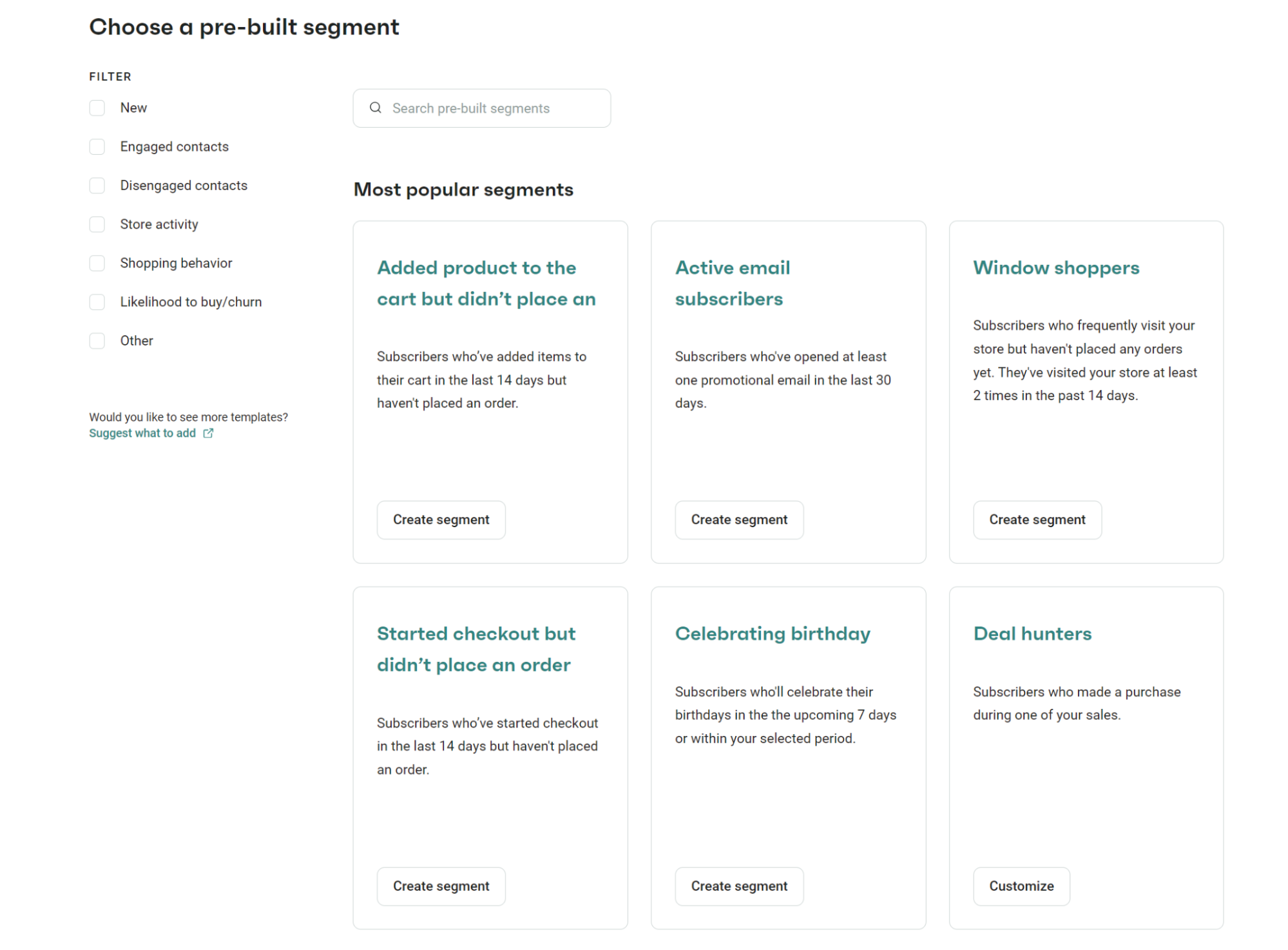
Step 3 — Choose the right email marketing platform
Ecommerce email marketing software needs three capabilities that matter:
- Real-time store sync keeps everything current. Inventory updates instantly. Abandoned carts trigger emails within minutes. Product recommendations reflect what’s actually in stock. No manual updates, no outdated information.
- Action-based targeting goes deeper than age or location. Yesterday’s buyers get different emails than last month’s browsers. Big spenders see VIP content. Bargain hunters receive sale alerts.
- Visual workflow builders show your entire customer journey. Drag triggers, drop emails, connect paths. Watch customers move from signup to purchase without writing code. Complex sequences become simple flowcharts.
Also, verify platform compatibility before committing — check Omnisend’s integrations for your complete tech stack (there are 160+):
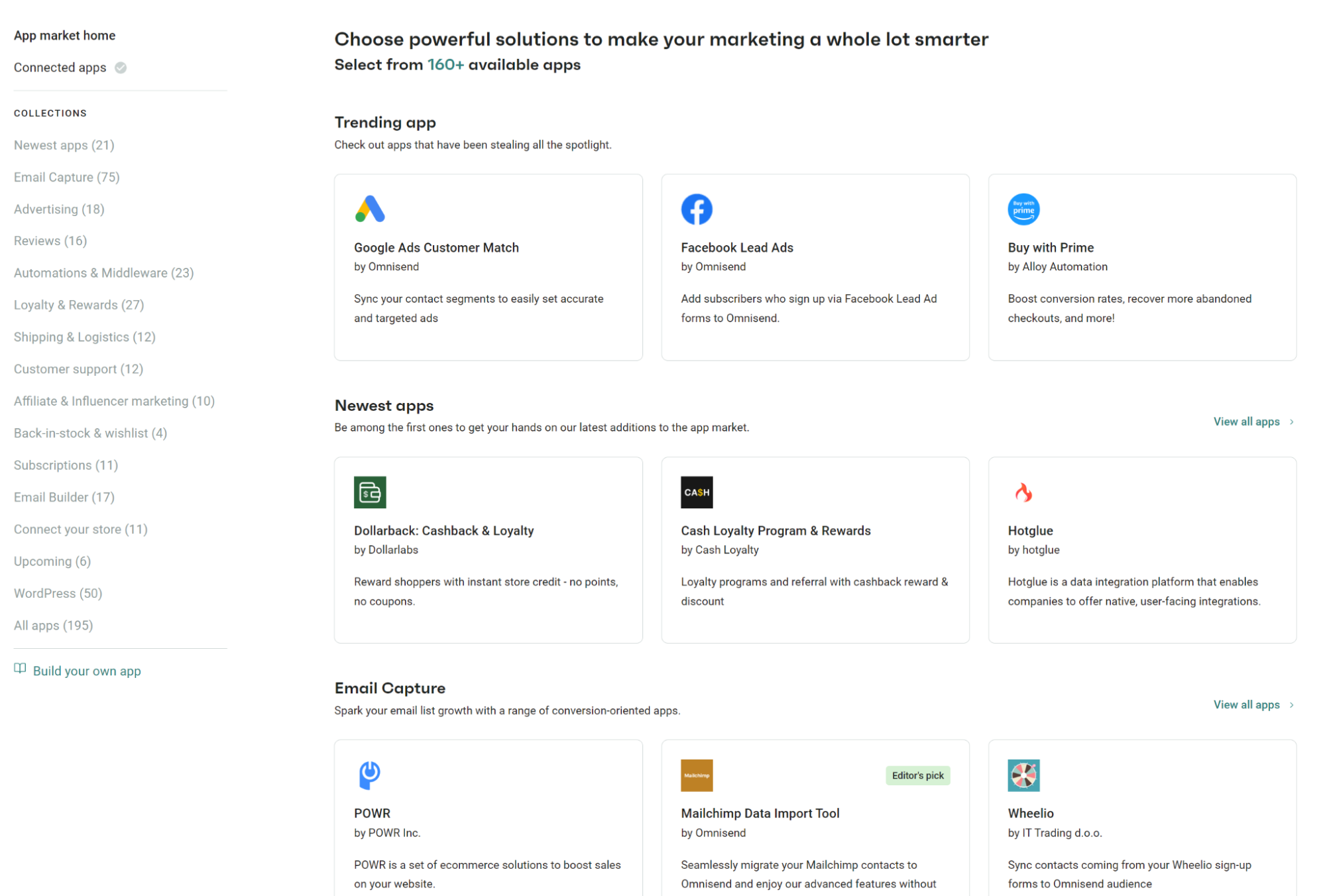
Step 4 — Build and grow your email list organically
Growing an email list requires strategy, not spam. Build your list from scratch by offering value in exchange for addresses.
- Strategic popups convert without annoying. Exit-intent catches abandoners. Time delays let visitors browse first. Scroll triggers reward engaged readers. Mobile-optimized forms prevent fat-finger frustration.
- Embedded forms capture natural interest. Blog readers already like your content. Product browsers show purchase intent. Footer forms catch determined scrollers — place forms where engagement happens naturally.
- Irresistible lead magnets solve problems. First-order discounts attract deal seekers. Size guides help uncertain shoppers. Recipe collections delight cooking enthusiasts. Browse newsletter signup examples that convert.
Omnisend has 100+ forms you can add to your store to build your list:
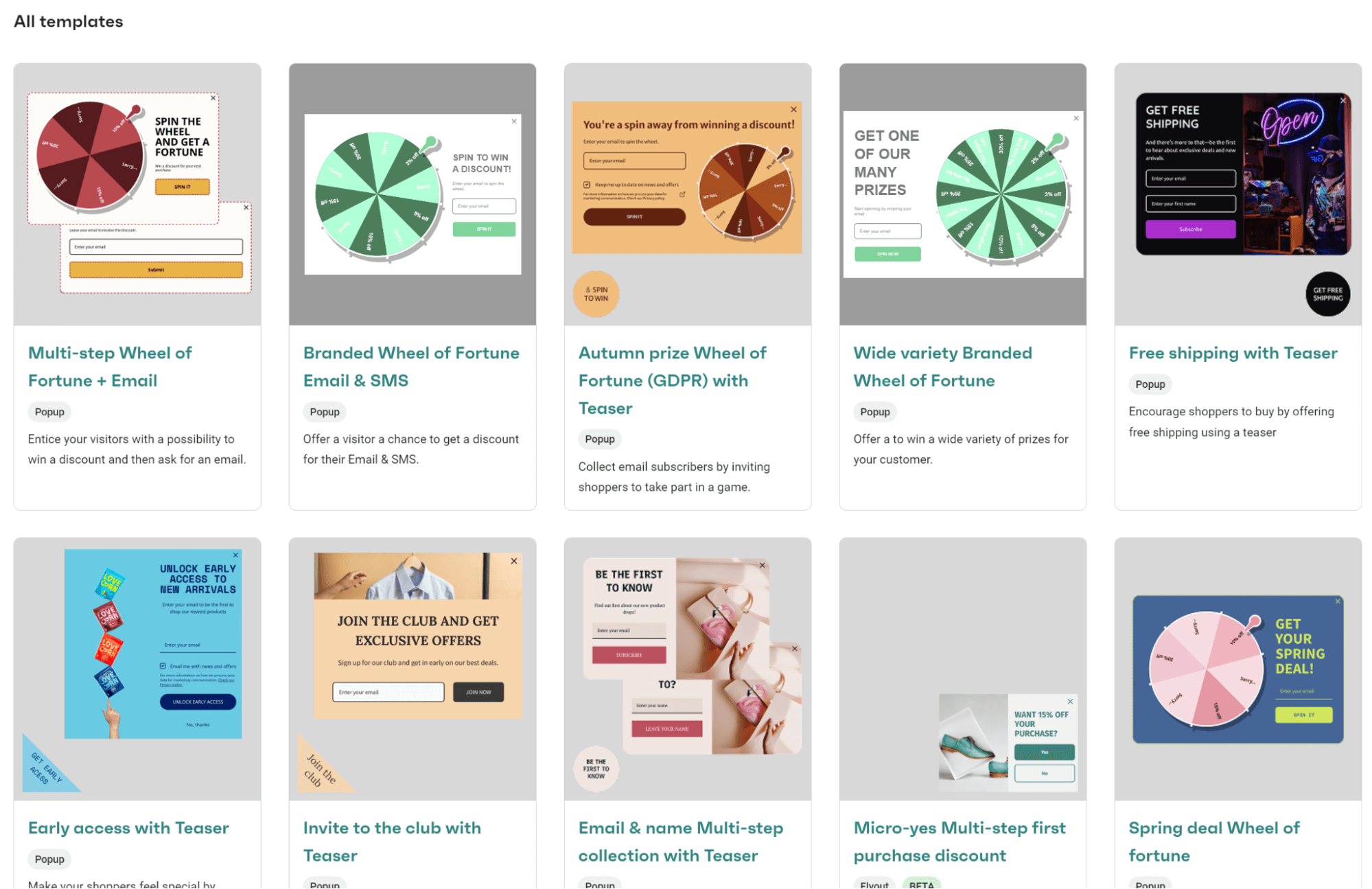
Remember that buying lists destroys deliverability. Purchased contacts mark you as spam, tank your sender reputation, and waste money on people who never wanted your emails.
Another way to grow your list is with social media — watch this video for tips:
Step 5 — Segment your audience for personalization
Demographics barely scratch the surface. Email segmentation targets behavior, value, and timing to deliver messages people want.
- VIP customers could generate a significant portion of your revenue, so reward them with exclusive previews, birthday surprises, and thank-you notes via exclusive emails.
- New customers need education, not promotion. Welcome sequences introduce your brand story. Product guides ensure satisfaction. Timely cross-sells suggest complementary items based on their first purchase.
- Lapsed buyers disappeared 60–90 days ago. Test their interest with graduated incentives — 10% off might work, or they might need 15%, or free shipping could seal the deal.
- Browsers without buyers show interest but hesitate. Send reminders featuring their viewed items, plus customer reviews. Add inventory warnings if stock runs low.
Layer these segments in Omnisend for precision — target high-value customers who haven’t bought recently differently than new subscribers browsing sale items.
Step 6 — Map your customer journey emails
Campaigns promote sales and share updates. Automations make money while you sleep. Omnisend data shows automated emails generate 37% of revenue from 2% of total sends — the math speaks for itself.
Essential automated journeys:
- Welcome emails that introduce your brand
- Cart recovery rescues sales within 72 hours (three emails)
- Post-purchase builds loyalty immediately (confirmation, shipping, review request)
- Browse abandonment re-engages within days (two to three emails)
- Win-back campaigns reactivate after 90 days (three emails over 30 days)
Set crystal-clear triggers and goals. Welcome flows start at signup to drive first purchases. Cart emails launch one to three hours after abandonment to recover revenue. Review requests arrive seven days post-delivery when satisfaction peaks.
Weekly campaigns maintain engagement between automated touchpoints — announce new arrivals, share seasonal content, and promote flash sales.
Omnisend has pre-built automations to get you up and running in no time, including flows for product reviews, cross-sells, and many more touchpoints:
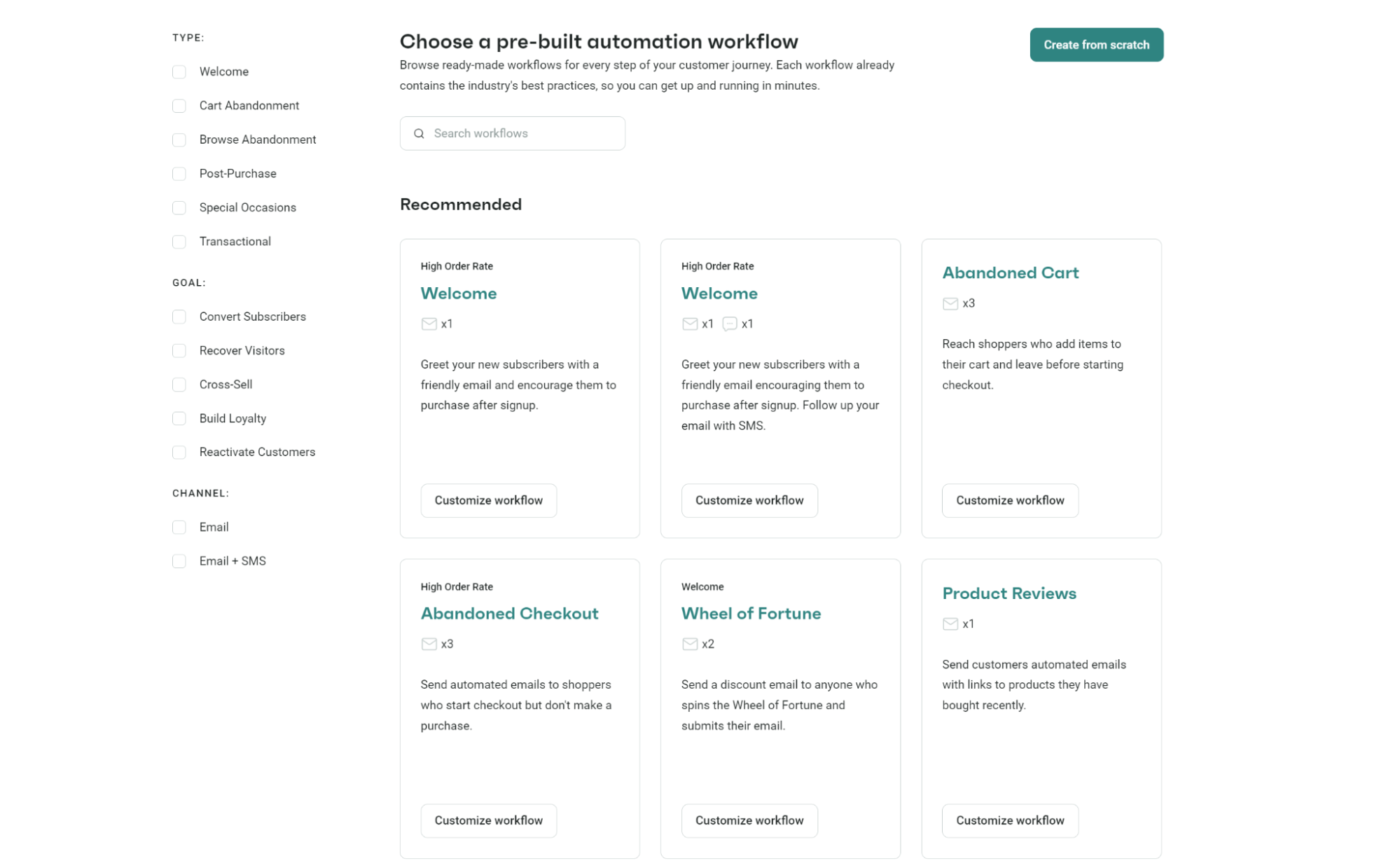
Step 7 — Design your emails and plan your calendar
Phones dominate email consumption. Single columns, large text (14px minimum), and thumb-sized buttons accommodate mobile readers. Desktop design comes second when 60% open on small screens.
Visual consistency reinforces your brand across every send. Colors, fonts, logos, and voice should connect welcome emails to shipping notifications to win-back campaigns. Scattered design confuses customers and reduces trust.
Omnisend lets you add brand assets to your account so that all email template designs import your logos and colors. Here are some of the templates to choose from:
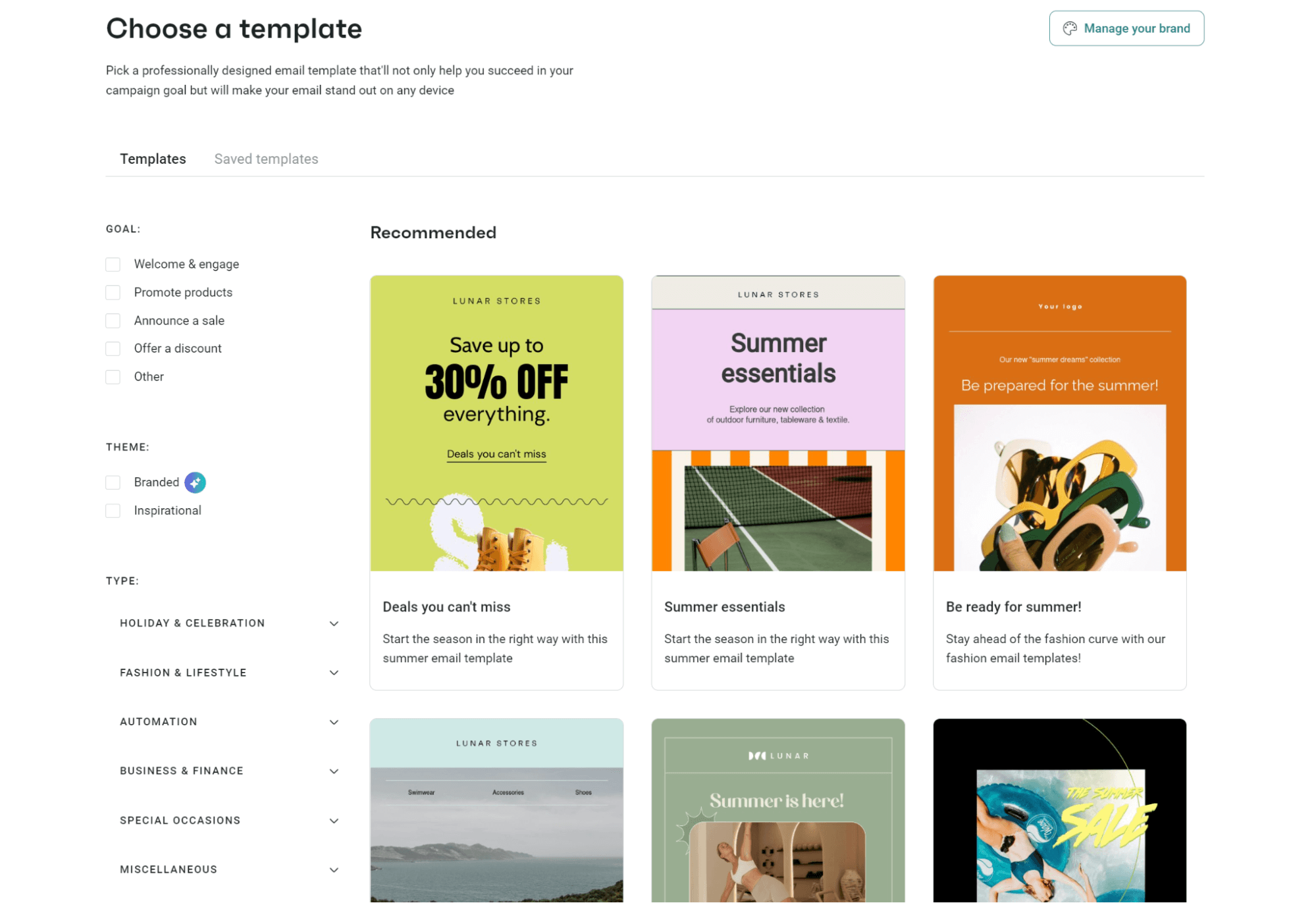
Find your ideal email cadence by testing. Two weekly emails might work perfectly, or your audience might want daily updates. Watch engagement metrics closely — rising unsubscribes signal too much, dropping opens suggest too little.
Holiday schedules need months of planning. Product launches require coordinated campaigns. Inventory clearances follow seasonal patterns. Save flexibility for breaking news and trending moments that demand a quick response.
These seven steps create your foundation. Success comes from testing, measurement, and refinement based on how your unique audience responds.
How to avoid common mistakes in ecommerce email marketing
Email marketing is least effective when you treat every subscriber identically, overwhelm their inbox, or ignore technical requirements that keep you out of spam folders.
Avoid these common mistakes for effective email marketing:
- Blasting everyone the same message — Segment by purchase history, browsing behavior, and engagement levels. VIP customers and window shoppers need different messaging.
- Bombarding subscribers daily — Find your sweet spot with testing. Most brands succeed with 2–4 weekly emails. Monitor unsubscribes to gauge email marketing frequency tolerance.
- Landing in spam folders — Warm up new sending domains gradually. Remove inactive subscribers quarterly. Follow authentication protocols. Master email deliverability basics before scaling.
- Ignoring mobile readers — Most of your customers will open on phones. Use single columns, 14px+ fonts, and thumb-sized buttons. Test every email on multiple devices, and optimize load times with image compression.
- Writing boring subject lines — “Newsletter #47” kills open rates. Create urgency, ask questions, or tease value, and test variations with Omnisend’s subject line tester.
- Breaking customer trust and spam laws — Include unsubscribe links, honor opt-outs immediately, and add physical addresses. Stay compliant with new email sending rules to protect deliverability.
Top 5 tools for ecommerce email marketing
Choosing a best-fit ecommerce email marketing platform impacts your revenue, customer relationships, and marketing efficiency. This comparison table highlights the top five platforms based on features, pricing, and user feedback:
| Platform | Best suited for | Free plan | Starting price | User ratings |
|---|---|---|---|---|
| Omnisend | Ecommerce stores of all sizes | ✅ Yes (250 contacts) | $16/month for 500 contacts | G2: 4.6, Capterra: 4.7 |
| Moosend | New ecommerce stores | ❌ No | $9/month for 500 contacts | G2: 4.7, Capterra: 4.6 |
| Drip | Stores needing extensive automations | ❌ No | $39/month for 2,500 contacts | G2: 4.4, Capterra: 4.4 |
| MailerLite | Small businesses and bloggers | ✅ Yes (1,000 contacts) | $10/month for 500 contacts | G2: 4.6, Capterra: 4.7 |
| ActiveCampaign | Businesses wanting built-in CRM | ❌ No | $15/month for a 10x contact send limit | G2: 4.5, Capterra: 4.6 |
How Omnisend can help you grow your store
You’ve learned the strategies — automated flows, behavioral segmentation, and data-driven testing. Here’s what Omnisend does to execute them:
List building
- Popups, Wheel of Fortune, and exit-intent forms capture emails
- Landing pages and embedded signup forms grow your subscriber base
- Sync existing Shopify customers automatically without manual imports
Segmentation
- Target by purchase history, browsing behavior, and engagement levels
- Layer conditions — VIP customers who haven’t bought recently versus new ones
- Real-time syncing means segments update as customers take actions
Automation
- Pre-built workflows for cart recovery, welcome series, and browse abandonment
- Visual drag-and-drop builder shows when emails trigger and where customers go
- One-click setup for essential flows — no coding or complex configuration
Campaigns
- Choose from hundreds of templates or build from scratch
- AI writes subject lines and body copy when you need inspiration
- Send now or schedule for optimal timing
Analytics
- Track revenue per email, conversion rates, and ROI by campaign
- See which automations generate the most sales
- Monitor list growth and engagement trends over time
A/B testing
- Test subject lines, send times, content, and sender names
- Automatic winner selection based on opens or clicks
- Apply winning variations across future campaigns
Quick sign up | No credit card required
FAQs
Omnisend delivers everything your ecommerce store needs — segments, automations, templates — ready to use. Moosend keeps things simple for newcomers. Drip tackles advanced workflows.
You should email both, but with different content. Your customers need transactional messages, reorder reminders, thank-you emails, and follow-ups, whereas newsletter subscribers are your best opportunities for deals and promotions.
Email sequences that run based on customer behavior. Abandoned carts trigger recovery messages with direct links back to checkout. New subscribers get a welcome series. Birthday emails are sent automatically on their special day.
Start with two emails weekly. Share customer photos, packing tips, founder stories, and product comparisons. Watch your metrics — climbing unsubscribes means dial it back.
Nothing for small lists, with plenty of platforms offering free plans under 1,000 contacts. Growing stores pay $15-50 monthly. Enterprise brands with 100,000+ subscribers should budget thousands. However, the ROI from email marketing is worth it for ecommerce.
TABLE OF CONTENTS
TABLE OF CONTENTS


No fluff, no spam, no corporate filler. Just a friendly letter, twice a month.
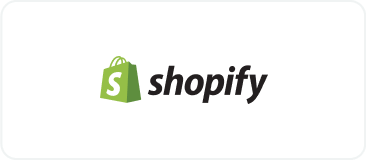
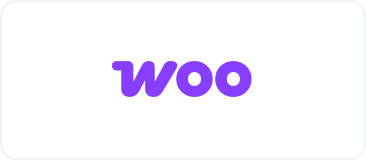 OFFER
OFFER

